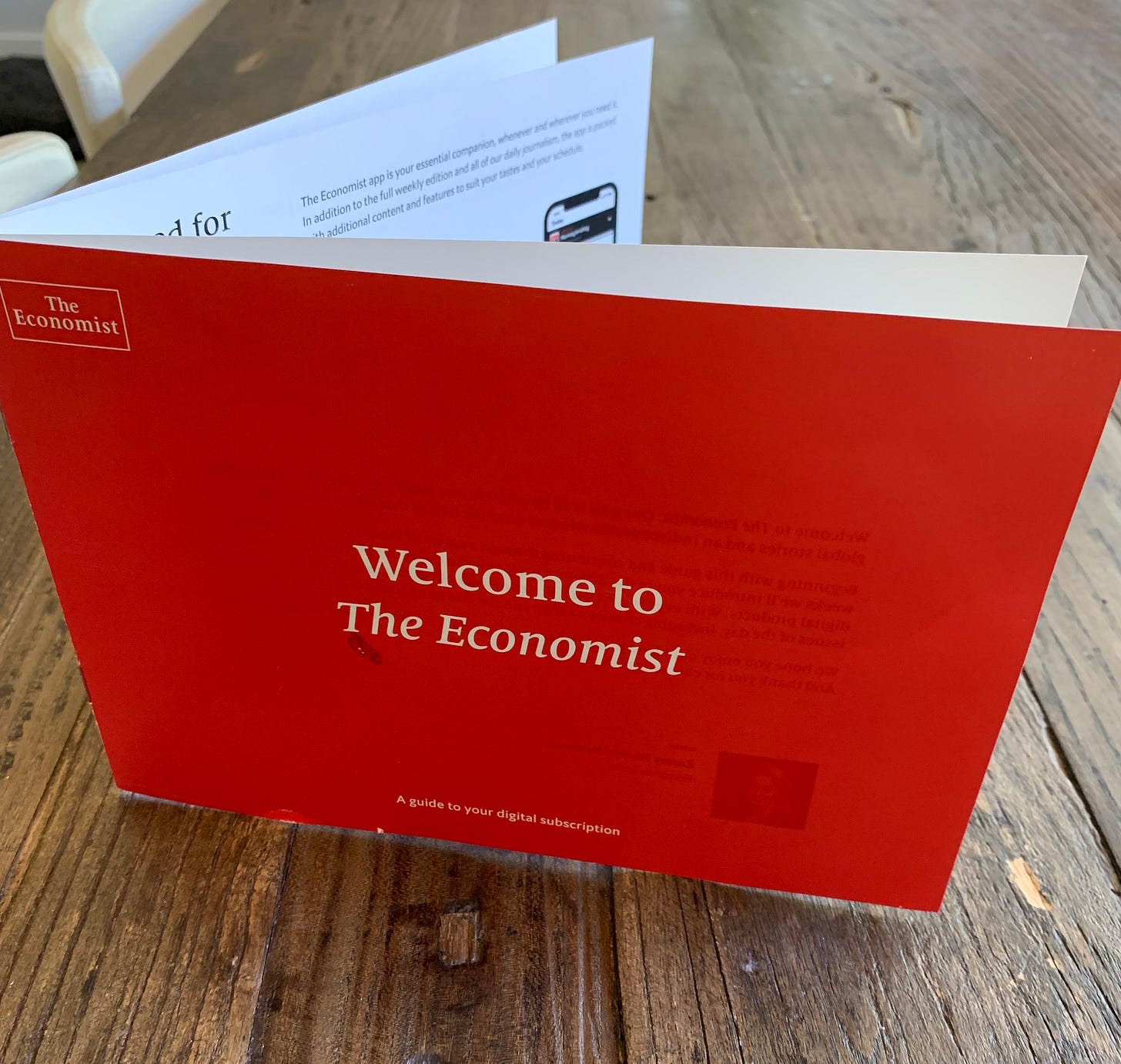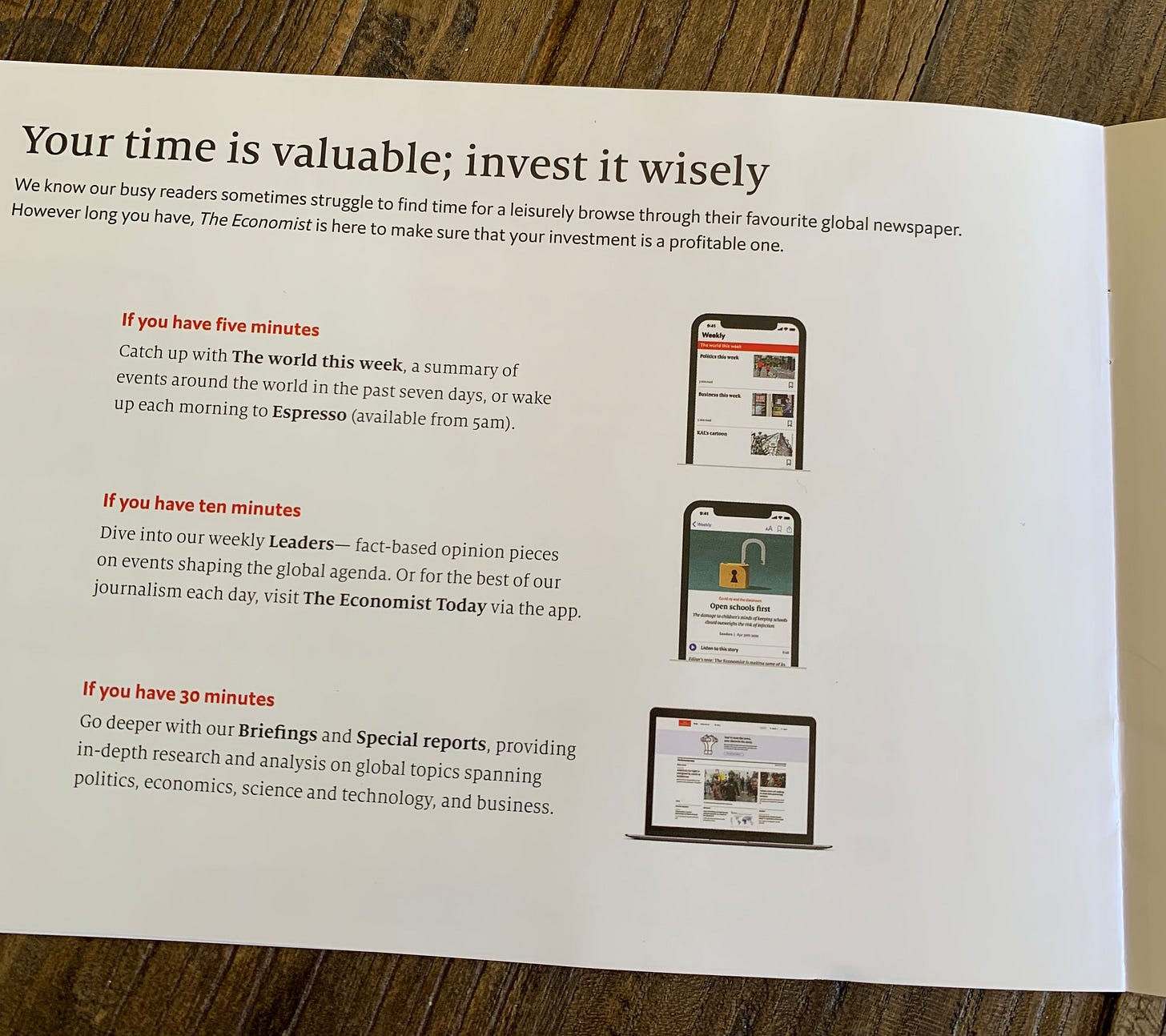Customer onboarding can be critical to engaging new subscribers - but how far do you take this? This week I take a look at my experience with The Economist. We also look at:
- a re-bundling
- the impact of churn
- Does the BBC have to build BBC Plus?
- and right at the very end a glimpse of the UI design that will dictate most of our digital experience
The Economist’s onboarding experience
In early April I took out a print and digital subscription to The Economist. Their excellent free emails led me to content that I could only access as a subscriber - so I bit the bullet and paid. I bought the print and digital subscription, pricing it at only £4 more than just digital worked for me. I decided to record how they onboarded me.
Welcome email
The Economist knows that if they get people to use their app you increase engagement and reduce the likelihood of churn. As I knew the print edition wouldn’t arrive within the next few days I downloaded the app. For the first couple of weeks it became my access point for The Economist. Strangely I didn’t use the website at all.
In the welcome email there’s a great welcome video (I didn’t watch it initially). It’s purpose is to show you how to get the most out of your subscription, again with an emphasis on using the app.
Through the post
A couple of weeks after I subscribed I received a separate letter from The Economist thanking for me for subscribing and with a printed guide (see below) on how to get the best out of my digital subscription.
Not sure whether I got this only because I didn’t watch the welcome video - nice move if that was the case
It was a real surprise and felt like it was a genuine attempt to help me make the most of their product
If subscriber usage of digital products is properly tracked it wouldn’t be too difficult for The Economist team to see whether this marketing material affects engagement. I’m guessing it does, otherwise why send it?
The call
About 5 weeks into my subscription I got a call on my mobile from a number I didn't recognise. I took it and it turned out to be someone from The Economist.
It was a well scripted call, the tone and the manner were also good - they were calling to ensure I was getting the most out of my subscription
They asked me whether I was aware of certain benefits of the app and explained what these were - I had pretty much stopped using the app since the print edition had started arriving
My guess is that not everyone receives this call, I’m pretty sure that I was phoned as my app usage had stopped as the print edition arrived.
A few thoughts
Using channels other than digital for engaging subscribers is smart, it cuts through the digital noise (I get far too many emails) and showcased the brand - this was really evident in the phone call
The onboarding activity addressed the critical issue of engaging the subscriber - too many businesses seem reluctant to do this - in case the customer cancels?
Focus on the benefit, not product features - too few companies think about what the product gives to the customer - that is where you’re providing value
All of this activity can be driven by data - there are plenty of signals to determine engagement and likelihood of cancelling, they should be used to communicate the right message at the right time to the right people. It also enables you to continue to do it even as subscriber numbers grow
Bundle bounce back?
Outside a media company that owns 30 different editorial brands in 4 segments - Healthy Living, Outdoor, Endurance and related industry titles has launched Outside+.
Outside+ is a unified membership bundle aimed at a broad “active lifestyle category”. Members who sign up get access to premium content across the range of titles, so that could be content form Yoga Journal to VeloNews. Beyond content members also get discounts on apparel, event passes and to a training plan platform. Outside+ will cost $99 a year. In the future it will also include a subscription box.
The company has been built on a foundation of legacy niche print publications, where they still have 1 million subscribers. In addition they have 500,000 digital subscribers who will now convert to Outside+
Enabling digital subscriptions to work by applying technology and marketing across multiple brands makes sense. But does it make sense to package such a broad bundle? Maybe the range doesn’t matter, if a customer finds additional value from just one more brand in the bundle, and this ensures they don’t churn then the approach pays dividends.
Axios provides great coverage which you can read here.
Churn’s impact
A company with a 2.5% churn rate will generate 50% more revenue than a company with a 5% churn rate - you can model the impact with this calculator here.
Segment a customer data platform vendor share 6 strategies to optimise customer retention, in part based on their own experience of running a subscription product.
Encourage new signups to take high-value product actions. For Segment a high value action is sending data into Segment. They nudge users to take that action. The Economist is clearly nudging users to launch the app.
Look at engagement, not just activity - not all activity is equal, users can display lots of low value activity - this might actually be a sign of a propensity to churn. Are users engaging in high-value activities over time?
Communicate ROI regularly - first you have to understand the value you are delivering to your customer. Once you do communicate regularly. In Segment’s instance this is showing the API calls made, where data is sent to etc.
Expand usage beyond the champion - this directly applies to SaaS companies where you have multiple users of a service. It might also apply to family streaming subscriptions - if only one person is using a family subscription they’re likely to cancel. Engage with all those signed up to the subscription.
Optimise your cancellation flow - one quick win is properly tackling involuntary churn. On a weekly basis that can account for 10-50% of all churning customers.
Learn from those who leave - customers are going to churn - ask why users are leaving, acknowledge the reasons and make sure they leave endeared towards the brand.
There’s a lot of useful detail in the article, including data tracked, email examples etc. Read more.
Why freemium isn’t as easy as it looks
Using a freemium model seems like a great way to get new customers to try your product. But, as this article (link below) reveals freemium shouldn’t be used by every business and if you get it wrong, the effect can be devastating.
When should you use a free tier?
It’s unlikely to work if your product has any physical element
When you can carve out a free tier eg does your product have enough functionality / content to enable more than one version? Or is the product complex / valuable enough that giving users a taste will reveal the value?
When the free tier move the customer towards purchasing?
The cost of free
Too often companies underestimate the cost of free - for SaaS companies maintaining the infrastructure necessary to serve millions of free customers can be substantial. The same applies to media companies - producing enough free content to engage users shouldn't be underestimated.
How to maintain value
The perceived value of your product is important, having a free tier can dilute that value so it’s important to limit the value users of the free version receive you can do this by:
Limiting the time period they have access to the product
Limiting the usage - and you should set the usage based on what is going to provide enough value / utility for them to convert
Limit the features / functionality / access
Free is definitely not an easy option but used well it can be the key to driving paid subscribers. Read more.
Netflix - experimentation built on psychological principles
According to this article Netflix underpins any experiments it makes to its user interface or marketing with 3 psychological principles.
Reciprocity - Robert Cialdini made the principle of reciprocity famous in his book “Influence - the psychology of persuasion”. Essentially if you give something to someone they are likely to respond in kind or as the author puts it “You’ve got to give to get”. Netflix originally used this in showing customers the whole catalog of TV shows and movies. But it turns out you can give too much, Netflix found that it was enough to give a peek at some of the content available.
The Cocktail Party effect - we focus our attention on things that are relevant to us. If you’re at a party and you overhear your name you immediately focus in on that conversation. Personalisation therefore has a direct effect on buying behaviour. According to Accenture, 65% of customers prefer to buy from a retailer who “knows their purchase history”.
Netflix strives to offer a personalised experience - more than 80% of Netflix shows customers watched were a direct results of Netflix’s recommendation engine. I find it surprising that other streaming services (that I use) are so poor at this, investing here should drive customer engagement.Idleness aversion - although it seems unlikely, we are actually happier when we are busy, even if we’re forced into action. Netflix’s auto play of trailers is idleness aversion in action - it forces you to engage when you dwell on a title. Like many others I often find this annoying but it definitely drives engagement and now I get frustrated when other services don’t auto play.
Not sure if this article entirely delivers on the title, but even so it’s a good reminder of the science that should be behind user interface design and marketing for subscription services. Read more.
Quick Links
The new company formed from the merger of Discovery and Warner Media announced its new name “Warner Bros. Discovery”. It also added a new slogan “the stuff that dreams are made of”. Of more interest might be the hints of a streaming “super pack” that combines all the companies assets in one service.
Substack is expanding its global footprint, distributing $1 million amongst 12 journalists to launch local newsletters in Romania, Ghana, Brazil, Taiwan and beyond. This will likely lead to local pricing as well.
Does the BBC have to build BBCPlus to ensure its financial stability? It has some incredible strengths - its respected brand and stable funding. But it would need to unwind its chaotic mix of small overseas deals. Coverage is by the FT so you either need a subscription or have to be prepared to answer a couple of questions to get access.
Cazoo the car buying service has launched a subscription product. Customers can subscribe to a car (of their limited choice) which includes insurance, maintenance, road tax and breakdown cover. As with other car subscriptions the price, even with everything it includes, looks expensive.
Material You - Google launched its new design language, watch the video below to get a flavour. Why is this included in a newsletter about subscriptions - if we’re building digital products then the user experience is critical and Material You from Google will change this.






